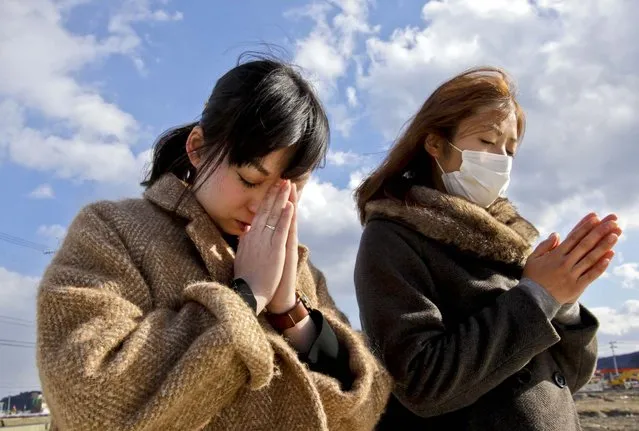
People offer prayers during a moment of silence in front of what is left of a disaster control center in an area devastated by the March 11, 2011 earthquake and tsunami in Minamisanriku, Miyagi Prefecture. Japan marked the second anniversary of the devastating disasters that left nearly 19,000 people dead or missing. (Photo by Shizuo Kambayashi/Associated Press)
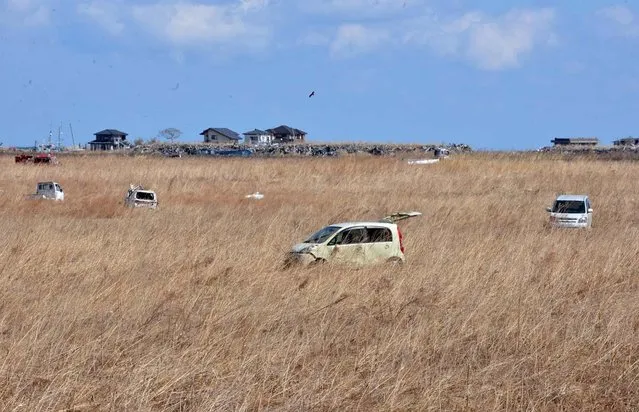
Wrecked vehicles remain in a field of reeds in Namie, two years after the March 11, 2011 tsunami and earthquake, near the striken TEPCO's Fukushima Dai-ichi nuclear plant in Fukushima prefecture on March 11, 2013. March 11, 2013 marks the second anniversary of the 9.0 magnitude earthquake that sent a huge wall of water into the coast of the Tohoku region, splintering whole communities, ruining swathes of prime farmland and killing nearly 19,000 people. (Photo by Yoshikazu Tsuno/AFP Photo)
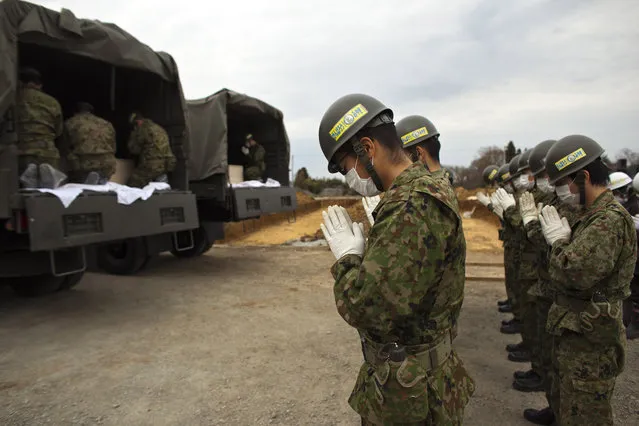
Japan Self-Defense Force members pay their respect to unidentified earthquake victims in vehicles during a mess funeral on April 8, 2011 in Yamamoto, Miyagi Prefecture, Japan. The 9.0 magnitude strong earthquake struck offshore on March 11 at 2:46pm local time, triggering a tsunami wave of up to ten metres which engulfed large parts of north-eastern Japan, and also damaging the Fukushima nuclear plant and threatening a nuclear catastrophe. The death toll continues to rise with numbers of dead and missing exceeding 20,000 in a tragedy not seen since World War II in Japan. (Photo by Athit Perawongmetha/Getty Images)
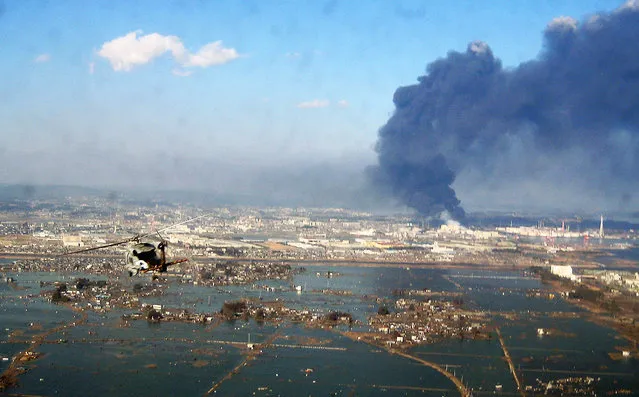
In this handout image provided by U.S. Navy, an aerial view of tsunami and earthquake damage is seen from an SH-60B helicopter assigned to the Chargers of Helicopter Antisubmarine Squadron (HS) 14 from Naval Air Facility Atsugi March 12, 2011 seen from the air of Sendai, Japan. An earthquake measuring 8.9 on the Richter scale has hit the northeast coast of Japan causing tsunami alerts throughout countries bordering the Pacific Ocean. (Photo by U.S. Navy via Getty Images)
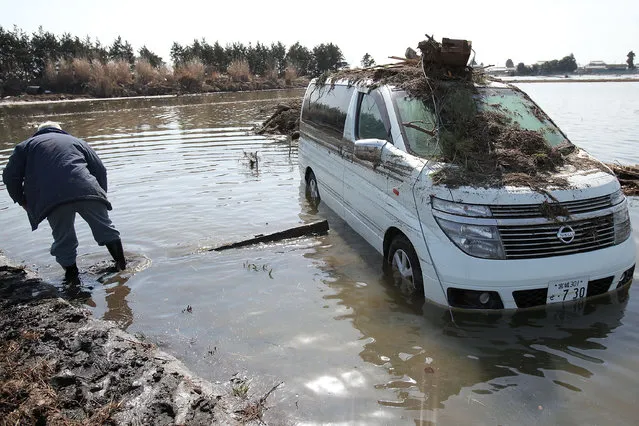
A local resident tries to approach a car left abandoned in the area damaged by tsunami after a 9.0 magnitude strong earthquake struck on March 11 off the coast of north-eastern Japan, on March 14, 2011 in Sendai, Japan. The quake struck offshore at 2:46pm local time, triggering a tsunami wave of up to 10 metres which engulfed large parts of north-eastern Japan. The death toll is currently unknown, with fears that the current hundreds dead may well run into thousands. (Photo by Kiyoshi Ota/Getty Images)
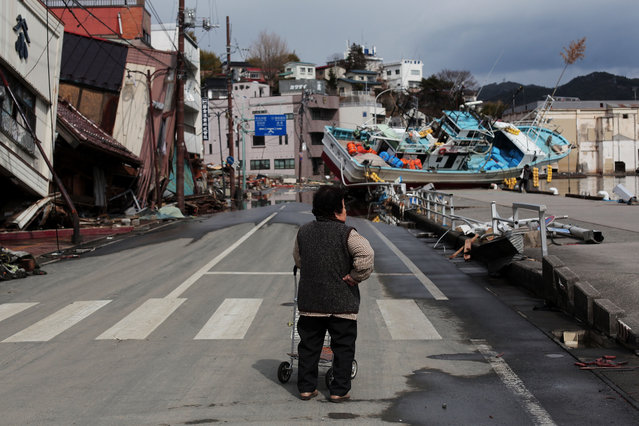
A woman surveys the damage after the earthquake on March 17, 2011 in Kensennuma, Japan. Residents were allowed back to their homes today and began the massive cleanup operation caused by a 9.0 magnitude strong earthquake that struck on March 11 off the coast of north-eastern Japan. The quake triggered a tsunami wave of up to 10 metres which engulfed large parts of north-eastern Japan. The death toll has risen past 5000 with at least 8600 people still missing. (Photo by Chris McGrath/Getty Images)
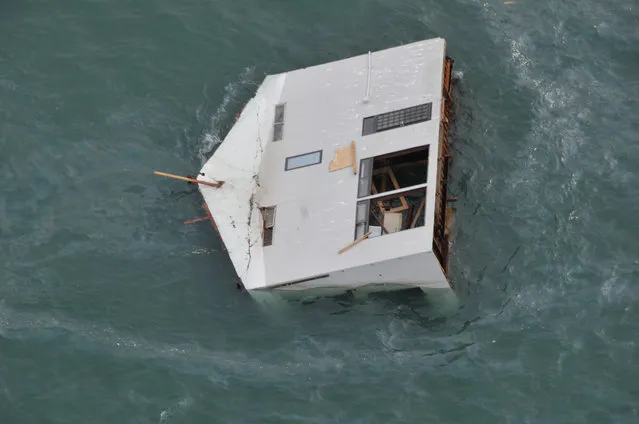
In this handout image provided by U.S. Air Force, a house is seen adrift off the coast of northeastern Japan from a HH-60G helicopter surveying the damage stricken area as part of Japan's earthquake and tsunami recovery effort March 14, 2011 in Japan. The quake struck offshore at 2:46 pm local time on March 11, triggering a tsunami wave of up to 10 metres which engulfed large parts of northeastern Japan. The death toll is still yet to be fully known, with fears that the numbers could run into the tens of thousands. (Photo by U.S. Air Force via Getty Images)
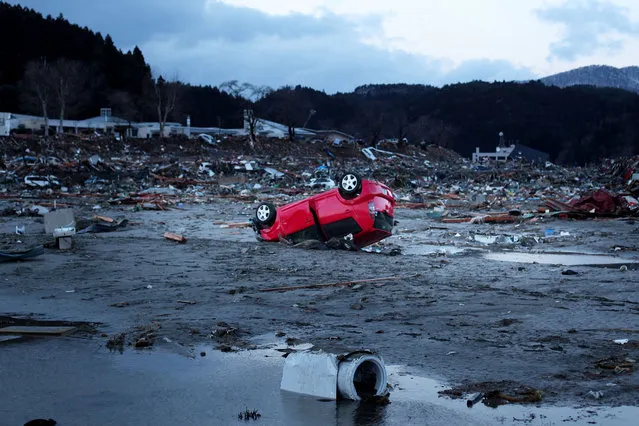
Destroyed vehicles lie near the rubble after the earthquake and tsunami devastated the area on March 16, 2011 in Minamisanriku, Japan. The 9.0 magnitude strong earthquake struck offshore on March 11 at 2:46pm local time, triggering a tsunami wave of up to ten metres which engulfed large parts of north-eastern Japan. The death toll continues to rise and could well reach 10,000 in a tragedy not seen since World War II in Japan. (Photo by Chris McGrath/Getty Images)
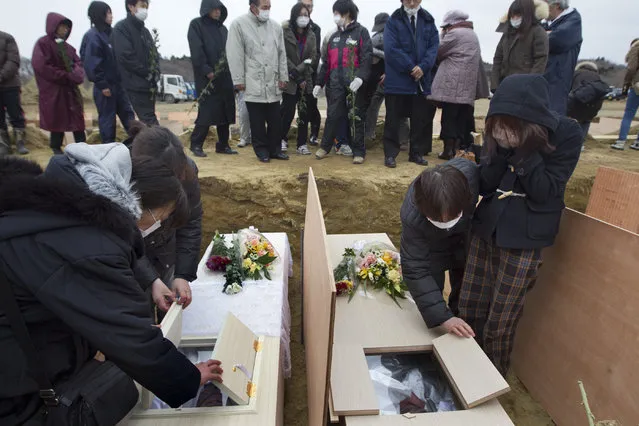
Families and relatives of the dead cry as they identify their family members at a temporary burial ground March 25, 2011 in Higashi Matsushima , Japan. Under Japanese Buddhist practice a cremation is the expected traditional way of dealing with the dead but now with the death toll so high crematoriums are overwhelmed and there is a shortage of fuel to burn them. Local municipalities are forced to dig mass graves as a temporary solution. Two weeks after the magnitude 9 earthquake and tsunami struck Japan the death toll has risen to 10,000 dead with still thousands missing and the expectation is that it will end up well over 20,000. Presently the country is still struggling to repair a damaged nuclear power plant that has caused tremendous problems, evacuations, and now tainted water supply in the Tokyo area causing more panic buying of bottled water. (Photo by Paula Bronstein/Getty Images)
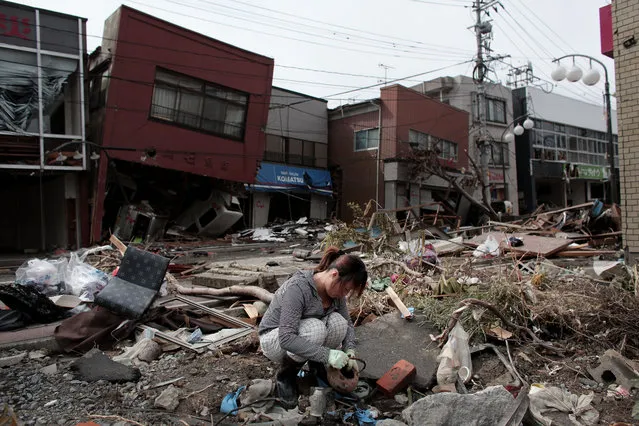
A woman sifts through the rubble of her home on March 17, 2011 in Kensennuma, Japan. Residents were allowed back to their homes today and began the massive cleanup operation caused by a 9.0 magnitude strong earthquake that struck on March 11 off the coast of north-eastern Japan. The quake triggered a tsunami wave of up to 10 metres which engulfed large parts of north-eastern Japan. The death toll has risen past 5000 with at least 8600 people still missing. (Photo by Chris McGrath/Getty Images)

In this handout image provided by U.S. Navy, A water pipe spews water after being damaged by a tsunami, which was triggered by a massive earthquake off the Northeastern coast March 12, 2011 in Hachinohe, Japan. An earthquake measuring 8.9 on the Richter scale has hit the northeast coast of Japan causing tsunami alerts throughout countries bordering the Pacific Ocean. (Photo by Daniel Sanford/ U.S. Navy via Getty Images)
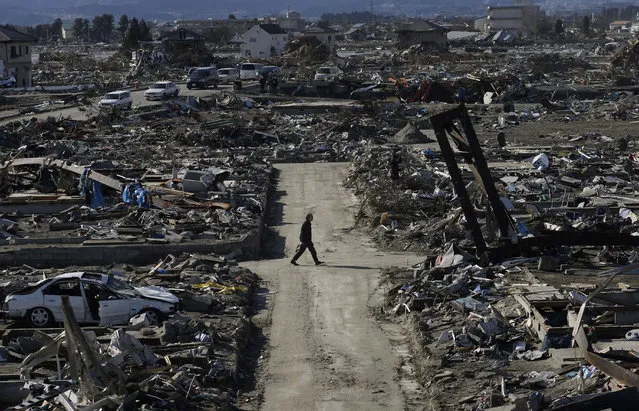
In this March 27, 2011 file photo, a man walks through the destroyed neighborhood below Weather Hill in Natori, Japan. Japan is marking the anniversary of the disaster Saturday, March 11, 2017 with somber ceremonies in Tokyo and in cities and towns in the northeast. Most of the towns devastated in the March 11, 2011 disasters have only partially rebuilt, and local authorities are struggling to finance construction. Meanwhile, despite an abundance of jobs thanks to the rebuilding, the population in most of the region is falling. (Photo by Wally Santana/AP Photo)
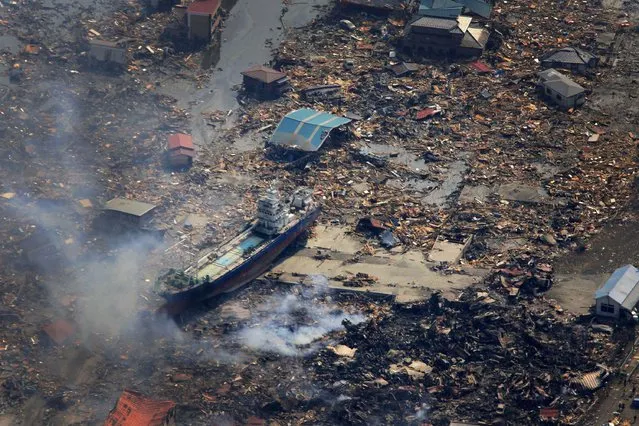
In this March 13, 2011 file photo. a ship washed away by tsunami sits amid debris in Kesennuma, Miyagi prefecture after Japan's biggest recorded earthquake hit its eastern coast. (Photo by Itsuo Inouye/AP Photo)
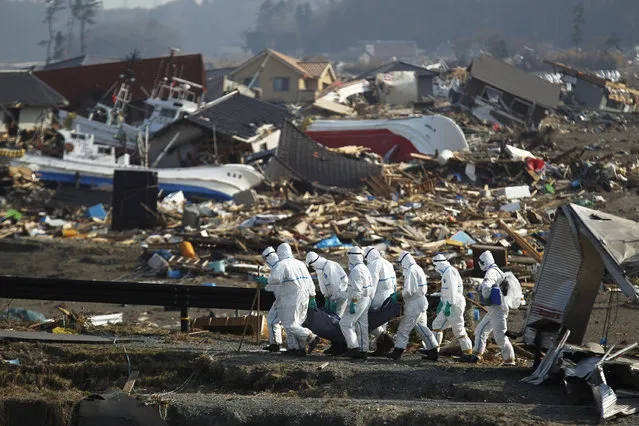
In this April 15, 2011 file photo, Japanese police officers carry a body during a search and recovery operation for missing victims in the area devastated by the March 11 earthquake and tsunami in Namie, Fukushima Prefecture, northeastern Japan. (Photo by Hiro Komae/AP Photo)
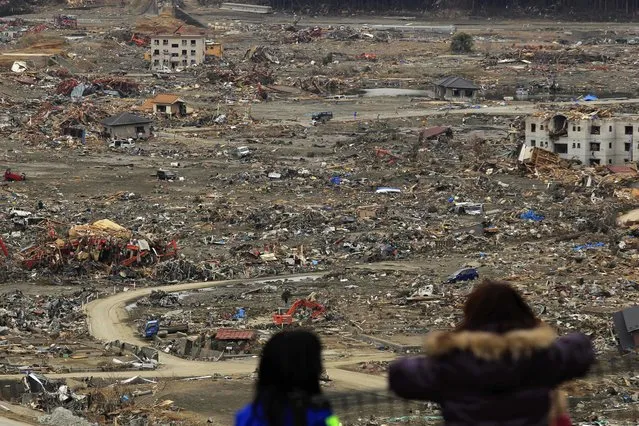
In the March 21, 2011, file photo, people look out at tsunami damage from a hill where there is a shelter set up in a school in Minamisanriku, Japan. (Photo by Matt Dunham/AP Photo)
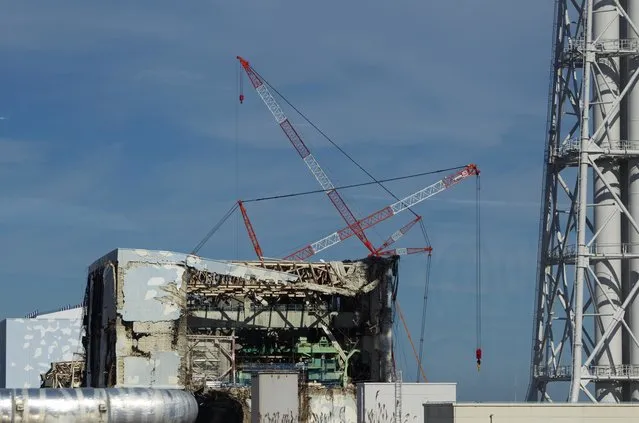
In this November 12, 2011 file photo, the Unit 4 reactor building of the crippled Fukushima Dai-ichi nuclear power station is seen through a bus window in Okuma, Japan, when the media were allowed into Japan's tsunami-damaged nuclear power plant for the first time since the March 11 disaster. (Photo by David Guttenfelder/AP Photo)
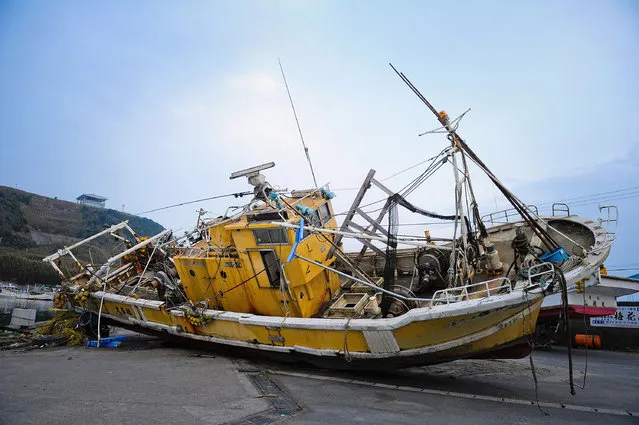
A fishing boat is washed onto the ground on March 20, 2011 in Asahi, Chiba, Japan. The 9.0 magnitude strong earthquake struck offshore on March 11 at 2:46pm local time, triggering a tsunami wave of up to ten metres which engulfed large parts of north-eastern Japan. The death toll continues to rise and could well reach 10,000 in a tragedy not seen since World War II in Japan. (Photo by Koki Nagahama/Getty Images)
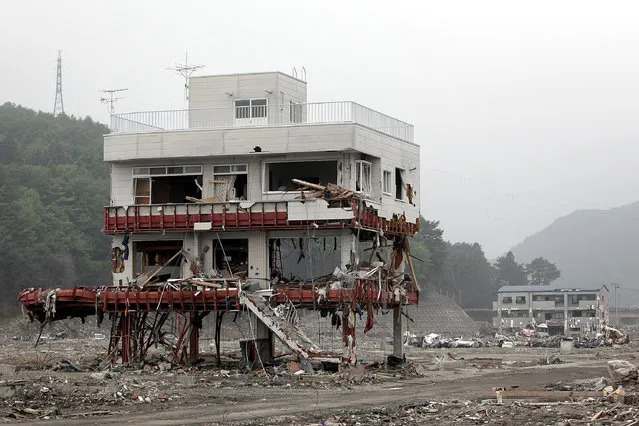
The remaining destroyed buildings stand in the tsunami-hit area on June 12, 2011 in Otsuchi, Iwate, Japan. Japanese government has been struggling to deal with the earthquake and tsunami as well as the troubled Fukushima Daiichi Nuclear Power Plant. The fear of infectious disease outbreak is mounting due to the humid rainy season and delay of the debris clearing. (Photo by Kiyoshi Ota/Getty Images)
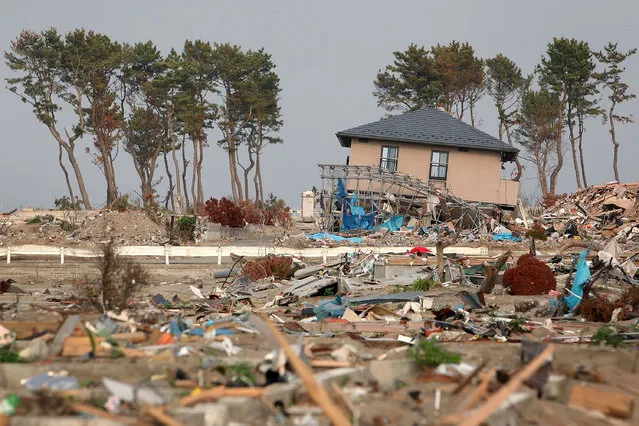
Debris is scattered, three months and two days after the magnitude 9.0 earthquake and subsequent tsunami on June 13, 2011 in Sendai, Miyagi, Japan. Japanese government has been struggling to deal with the earthquake and tsunami as well as the troubled Fukushima Daiichi Nuclear Power Plant. The fear on outbreak of virus infectious disease are mounting due to the humid rainy season on the corner and delay of the clearing the debris. (Photo by Kiyoshi Ota/Getty Images)
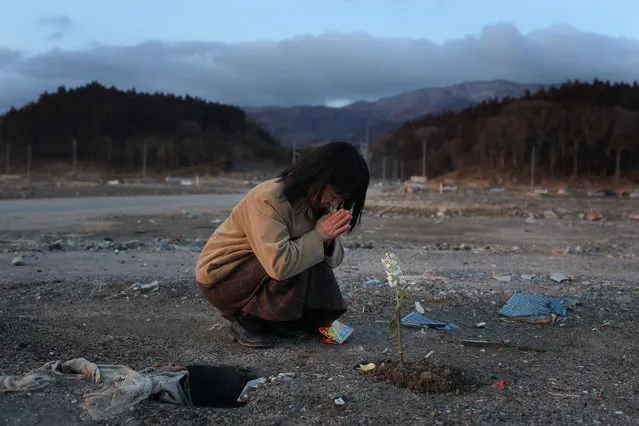
Keiko Suzuki, 40 prays at the site of her uncle's home on March 11, 2012 in Rikuzentakata, Japan. Her uncle Kazuyoshi Sugawara was killed when his home was swept away by the tsunami last year. On the one year anniversary, the areas most affected by last year's March 11, 2011 earthquake and subsequent tsunami that left 15,848 dead and 3,305 missing according to Japan's National Police Agency, continue to struggle. Thousands of people still remain without homes living in temporary dwellings. The Japanese government faces an uphill battle with the need to dispose of rubble as it works to rebuild economies and livelihoods. Across the country people are taking part in ceremonies to pay respects to the people who lost their lives. (Photo by Chris McGrath/Getty Images)
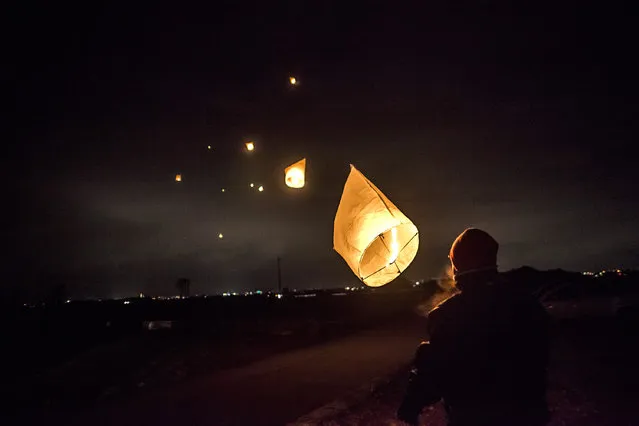
A man watches as his paper lantern, lit in commemoration of the victims of last year's earthquake and tsunami, floats away into the distance on March 11, 2012 in Natori, Japan. On the one year anniversary, the areas most affected by last year's March 11, 2011 earthquake and subsequent tsunami that left 15,848 dead and 3,305 missing according to Japan's National Police Agency, continue to struggle. Thousands of people still remain without homes living in temporary dwellings. The Japanese government faces an uphill battle with the need to dispose of rubble as it works to rebuild economies and livelihoods. Across the country people are taking part in ceremonies to pay respects to the people who lost their lives. (Photo by Daniel Berehulak/Getty Images)
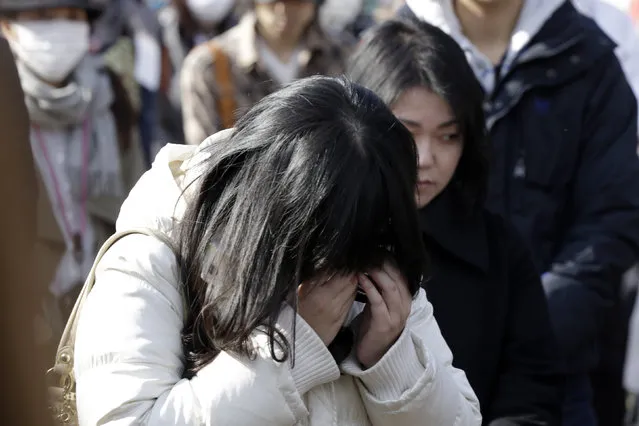
A woman cries as she mourns the victims of the March 11, 2011 earthquake and tsunami during a special memorial event in Tokyo, Saturday, March 11, 2017. Japan on Saturday marked the sixth anniversary of the 2011 tsunami that killed more than 18,000 people and left a devastated coastline along the country's northeast that has still not been fully rebuilt. (Photo by Eugene Hoshiko/AP Photo)
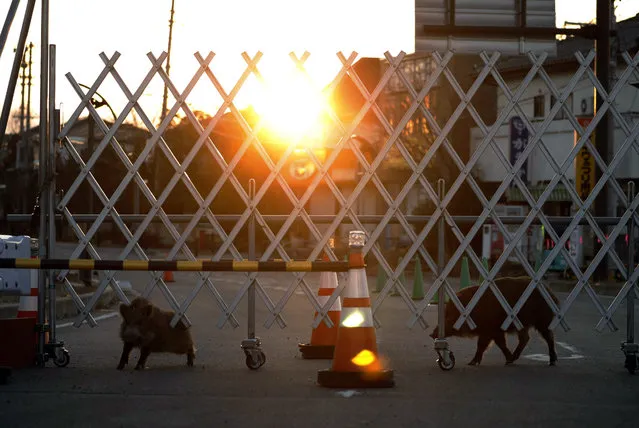
Boars roam near a barricade set up to restrict the entry to difficult-to-return zones in Futaba, near the tsunami-crippled Fukushima Dai-ichi nuclear plant, Fukushima prefecture, Japan Saturday, March 11, 2017. On Saturday, Japan is marking the anniversary of the 2011 massive earthquake and tsunami that struck the nation. (Photo by Kota Endo/Kyodo News via AP Photo)
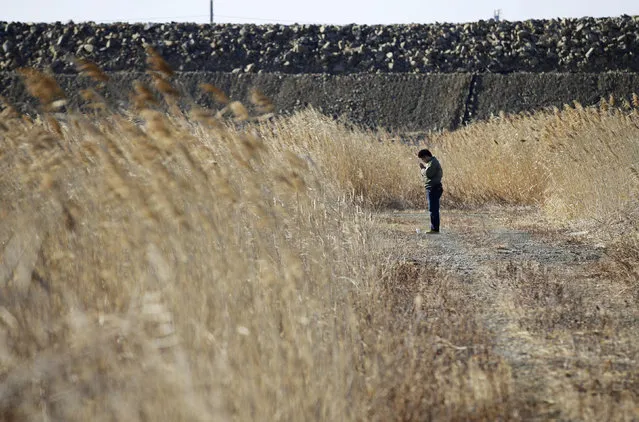
A man offers prayers at the site where a house of his missing colleague once stood, in Ishinomaki, Miyagi prefecture, Japan Saturday, March 11, 2017. On Saturday, Japan is marking the anniversary of the 2011 massive earthquake and tsunami that struck the nation. (Photo by Hiroki Yamauchi/Kyodo News via AP Photo)
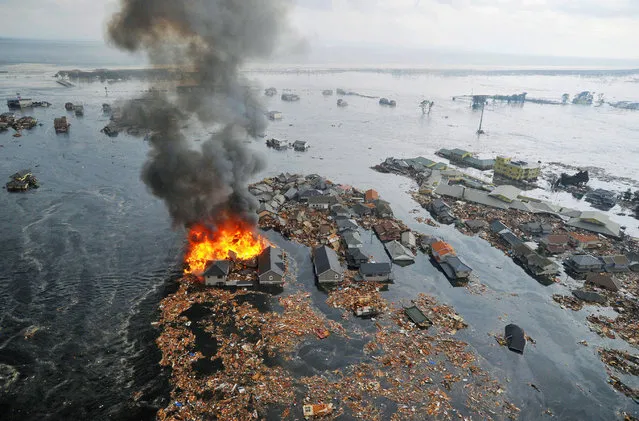
Houses are swept by water following a tsunami and earthquake in Natori City in northeastern Japan March 11, 2011. (Photo by Reuters/Kyodo News)
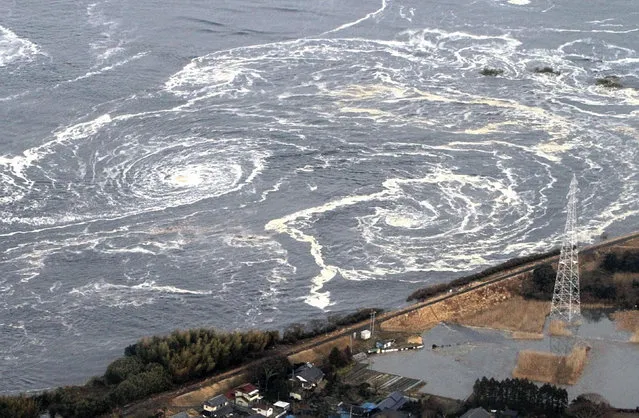
Whirlpools are seen following a tsunami and earthquake in Iwaki city, Fukushima Prefecture, March 11, 2011. (Photo by Reuters/Yomiuri)
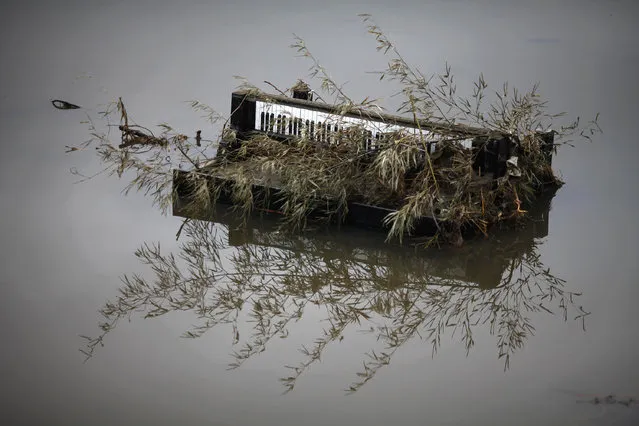
A piano is submerged in water in the area devastated by tsunami in Rikuzentakat March 21, 2011. (Photo by Damir Sagolj/Reuters)
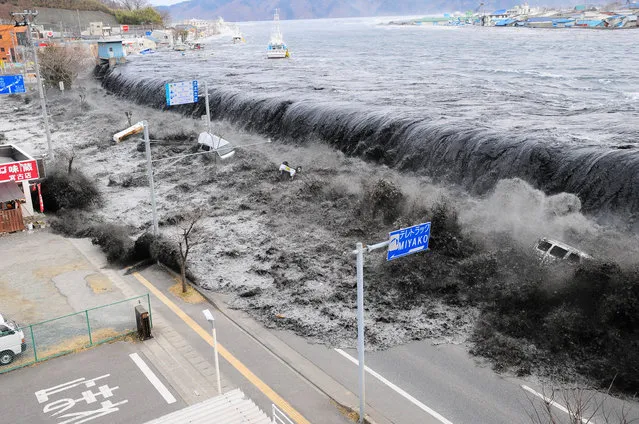
A wave approaches Miyako City from the Heigawa estuary in Iwate Prefecture after the magnitude 8.9 earthquake struck the area March 11, 2011. (Photo by Mainichi Shimbun/Reuters)
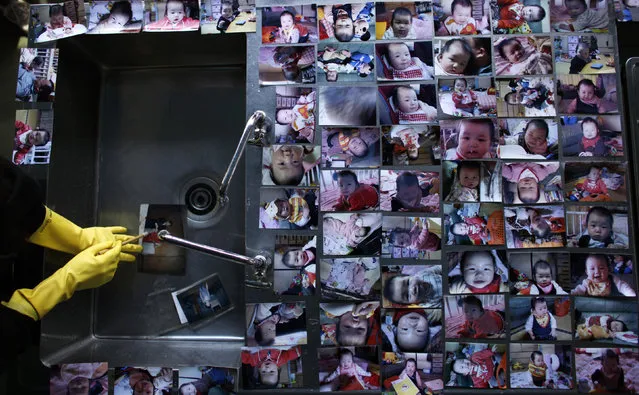
A volunteer cleans a family photo that was washed by the March 11 earthquake and tsunami as baby photos are placed to dry at a volunteer center in Ofunato, Iwate prefecture, April 12, 2011. (Photo by Toru Hanai/Reuters)
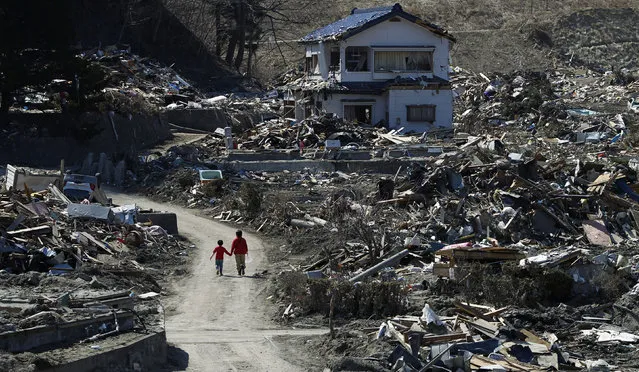
People walk at an area that was damaged by the March 11 earthquake and tsunami, in Miyako, Iwate prefecture, April 5, 2011. (Photo by Toru Hanai/Reuters)
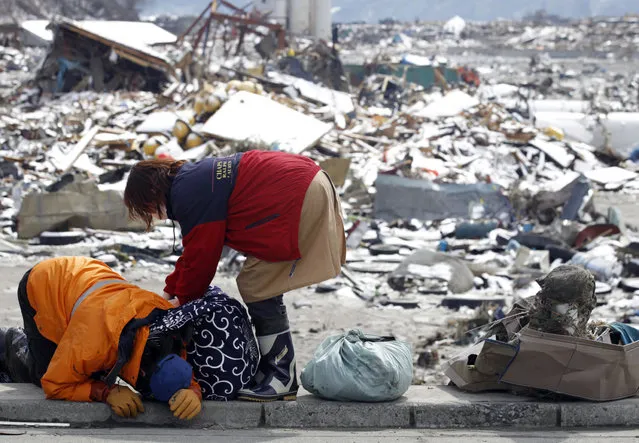
Survivors react after collecting their belongings at their destroyed house in a village hit by an earthquake and tsunami in Otsuchi, northeast Japan March 17, 2011. (Photo by Lee Jae-Won/Reuters)
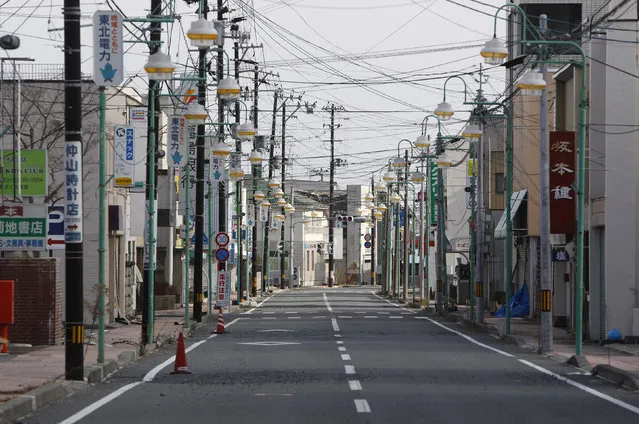
An empty shopping street is seen in Tomioka town, inside the exclusion zone of a 20km radius around the crippled Fukushima Daiichi nuclear power plant, Fukushima prefecture, January 15, 2012. (Photo by Issei Kato/Reuters)
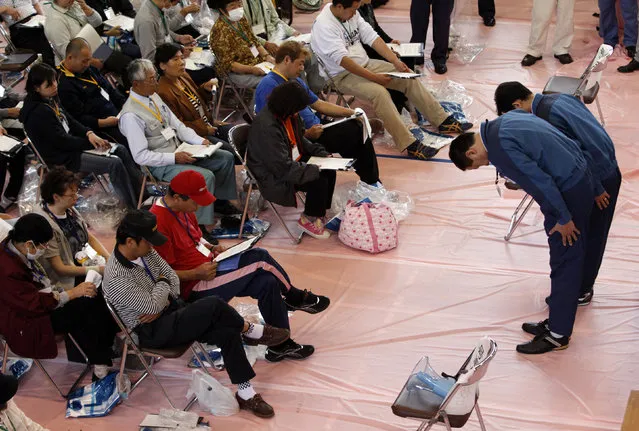
Employees of Tokyo Electric Power Co. (TEPCO) bow to evacuees from Kawauchi village as they prepare for a brief return to their homes inside the restricted zone of a 20km radius around the crippled Fukushima Daiichi Nuclear Power Plant, at a gymnasium in Kawauchi village, about 22 km (14 miles) from the plant in Fukushima prefecture May 10, 2011. (Photo by Issei Kato/Reuters)
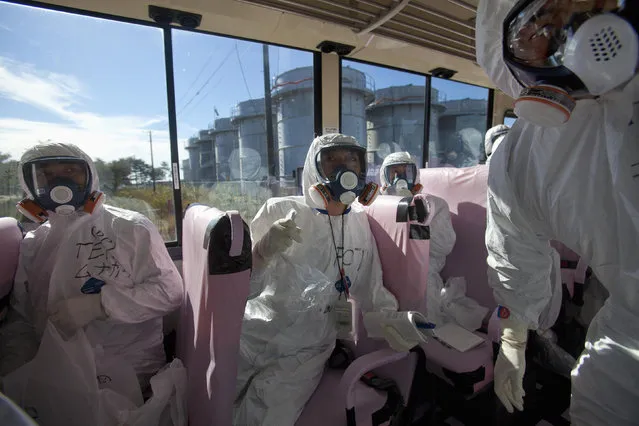
Officials from the Tokyo Electric Power Co. and Japanese journalists look at the crippled Fukushima Daiichi nuclear power plant from bus windows in Fukushima prefecture, November 12, 2011. (Photo by David Guttenfelder/Reuters)

Officials in protective gear check for signs of radiation on children who are from the evacuation area near the Fukushima Daini nuclear plant in Koriyama, March 13, 2011. (Photo by Kim Kyung-Hoon/Reuters)
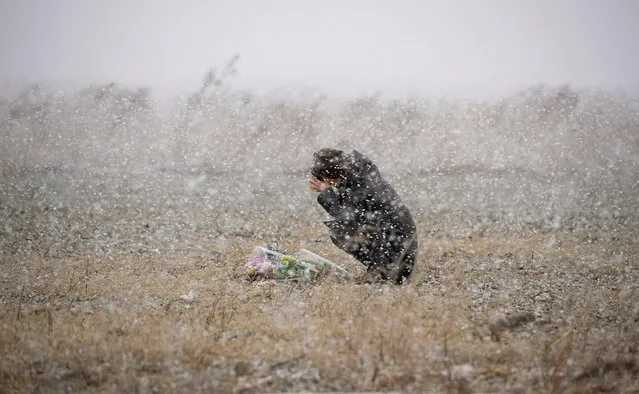
A woman prays for the deceased as snow falls, at a place where she was employed at a photo studio at the time, in Rikuzentakata, Iwate prefecture, March 11, 2014. (Photo by Reuters/Kyodo News)
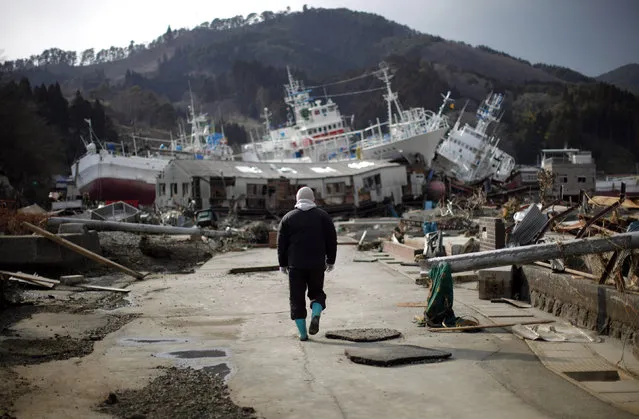
A man walks next to port area destroyed by the earthquake and tsunami in Kessenuma town, in Miyagi prefecture March 28, 2011. (Photo by Carlos Barria/Reuters)
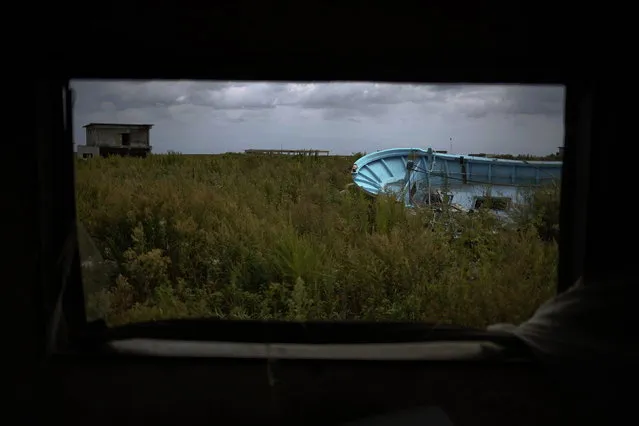
A fishing boat is seen on a field from inside an abandoned house in the evacuated town of Namie, September 23, 2013. (Photo by Damir Sagolj/Reuters)
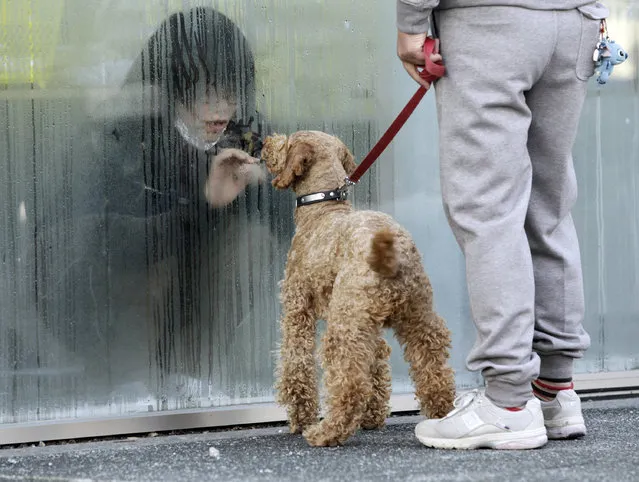
A girl who has been isolated at a makeshift facility to screen, cleanse and isolate people with high radiation levels, looks at her dog through a window in Nihonmatsu, northern Japan, March 14, 2011. (Photo by Yuriko Nakao/Reuters)
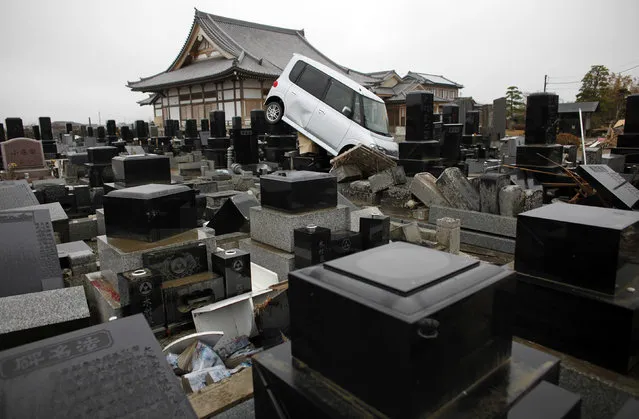
A damaged car is seen in a cemetery at an area devastated by the March 11 earthquake and tsunami, in Watari, Miyagi prefecture, April 22, 2011. (Photo by Toru Hanai/Reuters)
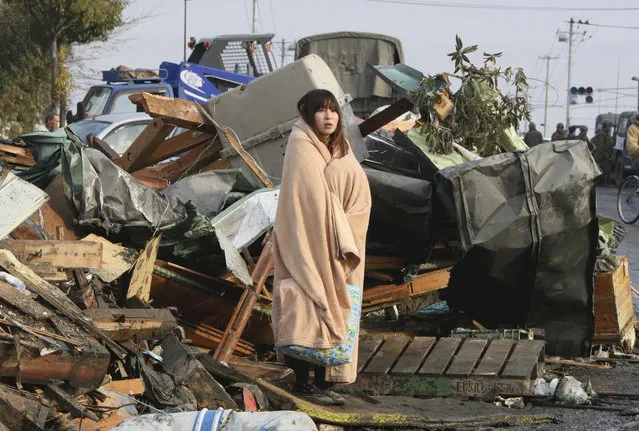
A woman looks at the damage caused by a tsunami and an earthquake in Ishimaki City, Miyagi Prefecture, after the magnitude 8.9 earthquake struck the area March 13, 2011. (Photo by Yomiuri Shimbun/Reuters)
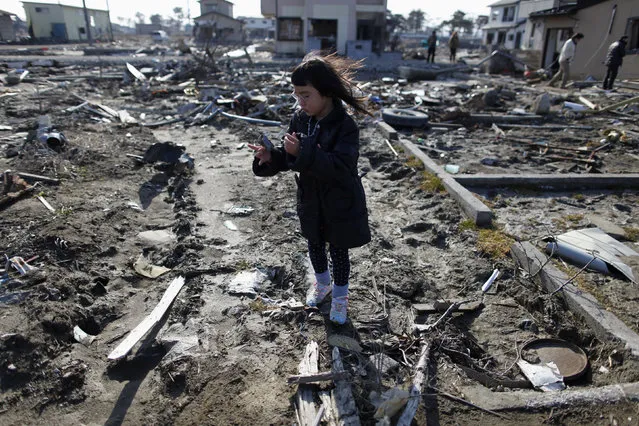
Wakana Kumagai, 7, visits the spot where her house, which was washed away by the tsunami, used to stand in Higashimatsushima, Miyagi prefecture March 11, 2012. (Photo by Toru Hanai/Reuters)
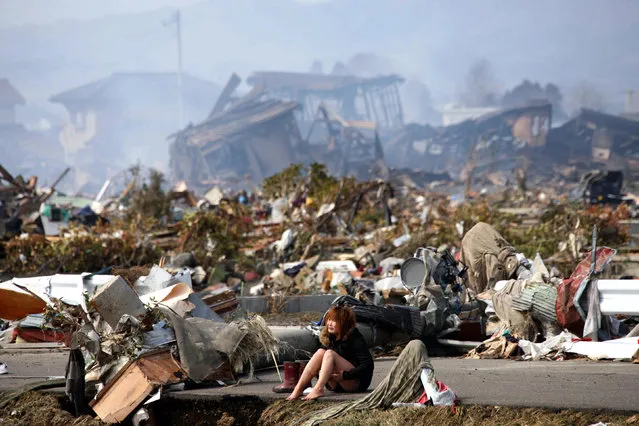
A woman cries while sitting on a road amid the destroyed city of Natori, Miyagi Prefecture in northern Japan March 13, 2011, after a massive earthquake and tsunami that are feared to have killed more than 10,000 people. (Photo by Asahi Shimbun/Reuters)
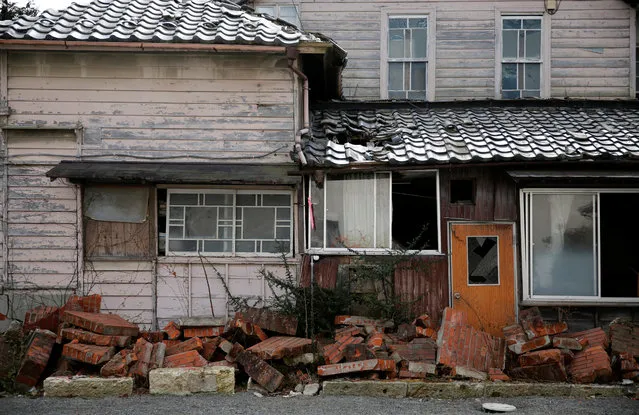
A house damaged by the tsunami is seen at a residential area in an evacuation zone in Namie, February 28, 2017. (Photo by Toru Hanai/Reuters)
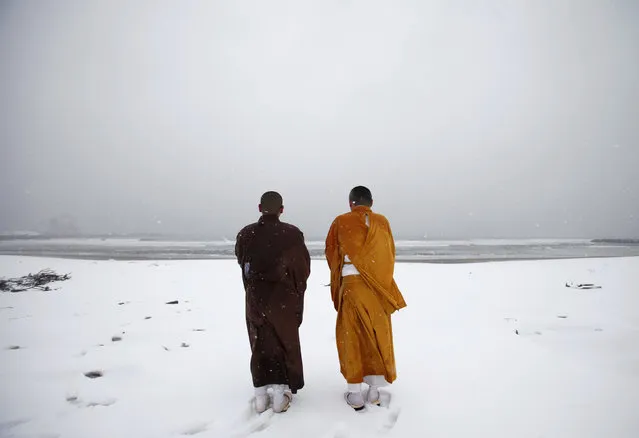
Buddhist monks offer prayers for victims at Kitaizumi beach in Minamisoma, Fukushima prefecture, March 10, 2012. (Photo by Yuriko Nakao/Reuters)
13 Mar 2017 00:05:00,
post received
0 comments
